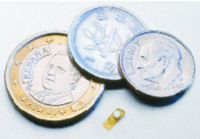Article
Fluocinolone acetonide implant heralds advances in posterior uveitis
On April 11, Bausch & Lomb announced that it had received FDA approval to market its intravitreal fluocinolone acetonide implant 0.59 mg (Retisert) for the treatment of chronic noninfectious uveitis affecting the posterior segment of the eye.

The company is targeting mid-year availability for Retisert, which represents the first intravitreal implant for the treatment of this devastating condition.
"This drug is a major advance for patients with chronic posterior uveitis who can suffer with pain, loss of vision, and from serious and even life-threatening side effects of systemic immunosuppressive drugs," said Glenn J. Jaffe, MD, professor of ophthalmology, a member of the Vitreoretinal Service and director of the Uveitis Service, Duke University Eye Center, Durham, NC. "The implant has been very effective in controlling inflammation, allowing patients to maintain or even improve their vision, and importantly permits them to decrease or avoid the need for toxic systemic medications."
Efficacy and safety results associated with the intravitreal corticosteroid implant were similar for both doses at 34 weeks. Based on comparisons with the 34-week pre-implantation period, the implant demonstrated benefits for significantly reducing uveitis recurrence rates and the need for adjunctive therapy with periocular steroid injections, topical steroid drops, and systemic immunomodulatory agents.
In addition, its use was associated with a statistically significant increase in vision.
The benefits of treatment with this implant in the clinical trials are so highly statistically significant that they speak for themselves, according to David Callanan, MD, a vitreoretinal specialist with private practice offices in the Dallas region, and assistant clinical professor of ophthalmology, University of Texas Southwestern Medical School, Dallas.
"Clearly, the fluocinolone acetonide implant is the most powerful tool that will be available to us for treating posterior segment uveitis," he said. "Its targeted local delivery makes it so effective that the recurrence rate in eyes with implants in the clinical trials has dropped almost to zero, and by reducing patient worries about relapses along with the side effects accompanying use of systemic immunosuppressive medications, it has also had a tremendous positive impact on quality of life."
Two-year data At the recent annual meeting of the Association for Research in Vision and Ophthalmology, Dr. Jaffe presented 2-year results from the first-launched of the two multicenter pivotal trials, and the benefits of the intravitreal fluocinolone implant continue to be impressive with lengthening follow-up.
That study, which is being conducted at 26 centers in the United States and one center in Singapore, randomly assigned 278 eyes of 278 patients to one of the two implant doses. About three-fourths of patients had bilateral disease, and in those individuals, the more severely affected eye was chosen as the study eye.
At 2 years, the rate of disease recurrence in the eyes with implants was 11.2%, which was significantly lower compared with both the 59.7% rate seen in the same eyes during the year prior to enrollment and the 50% rate occurring in fellow affected eyes during the first 2 years of the study. While at study entry, 52.5% of patients were receiving systemic steroids or immunosuppressive drugs for management of their uveitis and 68% had received periocular injections of steroids in the year prior to enrollment, at 2 years post-implantation, rates of use of those medications had declined to 12.5% and 9.7%, respectively. Meanwhile, the need for periocular steroid injections in fellow eyes increased significantly from 30.4% during the year prior to study entry to 45.3% at 2 years.
Newsletter
Don’t miss out—get Ophthalmology Times updates on the latest clinical advancements and expert interviews, straight to your inbox.





